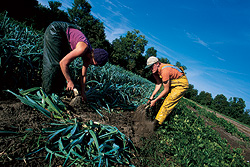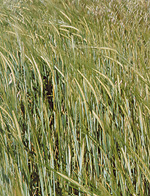


 |
Issue Contents :: Feature Stories :: Fields
Of Dreams :: Page [ 1 2 3 4 ]
Fields Of Dreams
In the soft sun of a mid-September afternoon, Andy Jones '91, head farmer of the Intervale Community Farm in Burlington, Vermont, stands before a small group of city dwellers gathered around a sandbox and carefully explains which pick-your-own crops are available this week.
 |
|
| Andy Jones '91 (right) and Intervale Community Farm worker Jennifer Woodworth pick and cut leeks. |
As a community-supported (CSA) farm, the Intervale Community Farm signs up paying members at the start of each season to share in the farm's bounty, as well as some of the up-front investment and risk. When all goes well, in addition to a generous weekly share of harvested produce, other fruits and vegetables are often available for picking. Today there are cherry tomatoes and green beans, as well as all kinds of herbs and unlimited flowers. "Everyone is entitled to a half-pint of raspberries from the field across the dirt road," Jones reminds them. "And feel free to snack on grapes, although they may be quite sour."
 |
|
Jones answers some questions, then half of the group heads out to the fields, including a younger woman in a wheelchair. The older visitors settle back into their benches to enjoy the scenery. As on most pick-up afternoons from spring through late fall, there's lots of activity. Toddlers dig in the sandbox while older children play tetherball next to a grape arbor. Guest musicians strum nearby, and a farm apprentice helps youngsters make vegetable creatures or fresh salsa. While CSA members weigh out their choices from the harvest piled high on long wooden tables, they catch up with friends and trade recipes. Today, three noticeably pregnant women are chatting next to a rack of freshly baked country loaves. Large coolers hold goat cheese, eggs, beef, and chickens from other local farms.
Theresa Smart is one of the senior citizens taking in the scene. Like many older Vermonters, she's proud of her roots: "I was raised on a farm, and I had a farm," she says. After retiring to the city 20 years ago, she's happy to be in her element once again. "It reminds me of the things I used to grow and make, like bread and butter pickles with brown sugar," she adds. Of her family's long-gone, 175-acre dairy farm north of Burlington, she says matter of factly, "It's all houses now."
 |
The nature of the American farm has changed radically over
the last 75 years, due in part to shifts in politics, society, and the
economy. In the early 1900s, one in three Americans lived on a farm. Today
farms are home to less than 2 percent of the U.S. population, and the
bulk of our nation's food supply comes from an ever-shrinking number
of large, specialized operations.
Proponents of modern agribusiness salute the industry's ability
to provide a consistent, plentiful, and generally safe supply of food
by leveraging efficiencies of scale with the latest technologies. But
detractors argue that modern farming requires huge amounts of fossil fuel
to transport food and promotes government-supported overproduction, contributing
to unprecedented levels of obesity in our country and an erosion of self-sufficiency
in developing nations. Furthermore, critics contend, the emphasis by modern
agriculture on machinery over people and of chemicals over natural land
management dangerously ignores the needs of both the environment and of
weakened rural communities.
The loss of the family farm is easily romanticized, but in truth, generations of farming families had little respite from repetitive and strenuous work, labor that rarely received respect outside farming circles. Nonetheless, David Orr, director of Oberlin's Environmental Studies Program, is quick to defend the profession. "Farms did what no other institution has ever done as well. They taught directly—and sometimes painfully—the relationship of our daily bread with soil, rainfall, animals, biological diversity, and natural cycles.
"Farms also taught the importance of the human qualities of husbandry, patience, hard work, self-reliance, practical skill, and thrift," he adds. "However imperfectly, farms served as a reality check on human possibilities in nature that urban societies presently lack."
Orr speaks eloquently in favor of what he and other environmental advocates call sustainable farms. "We need smaller-scale farms, powered by sunshine, that conserve biological diversity, serve local and regional markets with a diverse array of crops and products, and sequester carbon dioxide," he says. "Farms need to be tailored to the specific conditions of particular places, and they need more than ever to be ecologically resilient, intensively managed, and economically agile. We need to attract a new generation of young people to agriculture and make such enterprises affordable and profitable for them."
Jones in Vermont is one of several Oberlin alumni throughout the country whose farming operations have created a new breed of the "family" farm. While some of these farms do involve biological kin, others create a sense of family within the communities they serve. All are places where people personally know the farmers who grow their food, where children see vegetables growing in the dirt and chickens laying eggs, and where farmers work with nature, not against it.